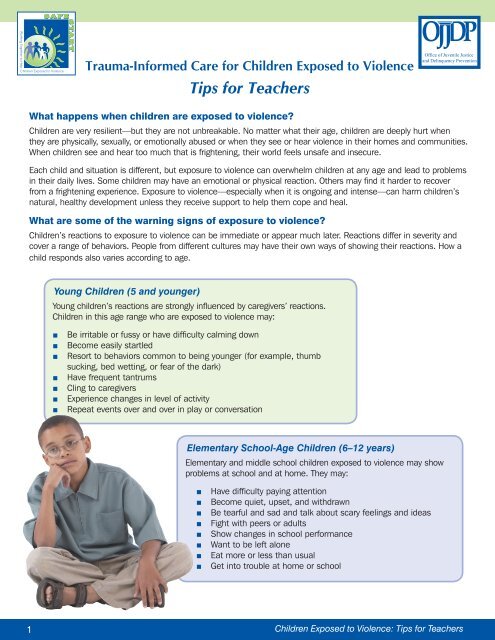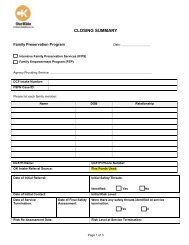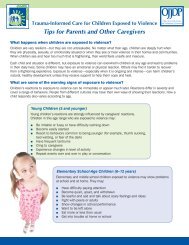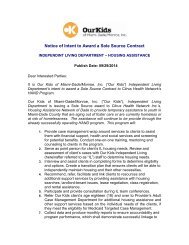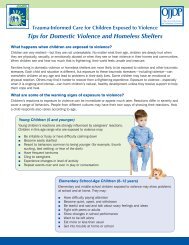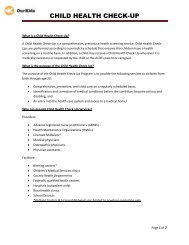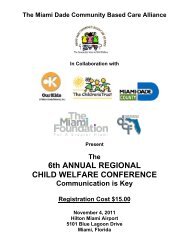Tips for Teachers - Safe Start Center
Tips for Teachers - Safe Start Center
Tips for Teachers - Safe Start Center
You also want an ePaper? Increase the reach of your titles
YUMPU automatically turns print PDFs into web optimized ePapers that Google loves.
Trauma-In<strong>for</strong>med Care <strong>for</strong> Children Exposed to Violence<br />
<strong>Tips</strong> <strong>for</strong> <strong>Teachers</strong><br />
What happens when children are exposed to violence?<br />
Children are very resilient—but they are not unbreakable. No matter what their age, children are deeply hurt when<br />
they are physically, sexually, or emotionally abused or when they see or hear violence in their homes and communities.<br />
When children see and hear too much that is frightening, their world feels unsafe and insecure.<br />
Each child and situation is different, but exposure to violence can overwhelm children at any age and lead to problems<br />
in their daily lives. Some children may have an emotional or physical reaction. Others may find it harder to recover<br />
from a frightening experience. Exposure to violence—especially when it is ongoing and intense—can harm children’s<br />
natural, healthy development unless they receive support to help them cope and heal.<br />
What are some of the warning signs of exposure to violence?<br />
Children’s reactions to exposure to violence can be immediate or appear much later. Reactions differ in severity and<br />
cover a range of behaviors. People from different cultures may have their own ways of showing their reactions. How a<br />
child responds also varies according to age.<br />
Young Children (5 and younger)<br />
Young children’s reactions are strongly influenced by caregivers’ reactions.<br />
Children in this age range who are exposed to violence may:<br />
■■<br />
■■<br />
■■<br />
■■<br />
■■<br />
■■<br />
■■<br />
Be irritable or fussy or have difficulty calming down<br />
Become easily startled<br />
Resort to behaviors common to being younger (<strong>for</strong> example, thumb<br />
sucking, bed wetting, or fear of the dark)<br />
Have frequent tantrums<br />
Cling to caregivers<br />
Experience changes in level of activity<br />
Repeat events over and over in play or conversation<br />
Elementary School-Age Children (6–12 years)<br />
Elementary and middle school children exposed to violence may show<br />
problems at school and at home. They may:<br />
■■<br />
■■<br />
■■<br />
■■<br />
■■<br />
■■<br />
■■<br />
■■<br />
Have difficulty paying attention<br />
Become quiet, upset, and withdrawn<br />
Be tearful and sad and talk about scary feelings and ideas<br />
Fight with peers or adults<br />
Show changes in school per<strong>for</strong>mance<br />
Want to be left alone<br />
Eat more or less than usual<br />
Get into trouble at home or school<br />
1 Children Exposed to Violence: <strong>Tips</strong> <strong>for</strong> <strong>Teachers</strong>
<strong>Safe</strong> <strong>Start</strong>: Working Together to Help Children Exposed to Violence<br />
Teenagers (13–18 years)<br />
Older children may exhibit the most behavioral changes as a result of exposure<br />
to violence. Depending on their circumstances, teenagers may:<br />
■■<br />
■■<br />
■■<br />
■■<br />
■■<br />
■■<br />
■■<br />
■■<br />
■■<br />
Talk about the event all the time or deny that it happened<br />
Refuse to follow rules or talk back with greater frequency<br />
Complain of being tired all the time<br />
Engage in risky behaviors<br />
Sleep more or less than usual<br />
Increase aggressive behaviors<br />
Want to be alone, not even wanting to spend time with friends<br />
Experience frequent nightmares<br />
Use drugs or alcohol, run away from home, or get into trouble with the law<br />
What can teachers do?<br />
<strong>Teachers</strong> can play a critical role in preventing and<br />
reducing the impact of exposure to violence on children.<br />
They can help children by creating a predictable<br />
environment, listening to students’ stories, and assuring<br />
children and adolescents that whatever happened was<br />
not their fault.<br />
Specific ways to help children exposed to violence<br />
include:<br />
Knowing and watching <strong>for</strong> signs of possible<br />
exposure to violence<br />
No single behavior proves that a child has been exposed<br />
to violence, but teachers can watch <strong>for</strong>:<br />
■■<br />
■■<br />
■■<br />
Physical signs such as bruises<br />
Unexplained changes in behavior<br />
Emotional signs such as depression, mood swings,<br />
and fearful or anxious behavior<br />
Depending on the age of the child, teachers can observe<br />
if a young child is crying more than usual, is difficult to<br />
calm, startles easily, or screams and panics during sleep.<br />
School-age children may become more aggressive and<br />
fight a lot, return to old fears or develop new ones,<br />
become apprehensive about going home, express a<br />
wish that the teacher were the parent, or become overly<br />
active.<br />
Teenagers may use violence to get what they want, rebel<br />
in school, stop being concerned about their appearance,<br />
or refuse to follow rules.<br />
Responding appropriately to children’s disclosures<br />
A teacher’s willingness to listen to a child’s story can<br />
provide the foundation on which to increase resilience<br />
and personal strength. The most meaningful assistance<br />
teachers can offer children exposed to violence is a safe<br />
and com<strong>for</strong>table environment where children can talk.<br />
Students may talk about exposure to violence all at once<br />
or in bits and pieces and “test” the teacher’s responses.<br />
The teacher’s first responsibility is to follow school<br />
policies and procedures and refer the child to specialized<br />
professionals such as the school social worker or<br />
psychologist.<br />
Supporting the healing process<br />
Experts agree that a child’s relationship with a caring<br />
adult is critical <strong>for</strong> developing resilience and beginning<br />
the healing process. It is very important that students<br />
have an opportunity to talk about what they have<br />
witnessed and how they feel with caring teachers who<br />
can listen and understand.<br />
Another important priority <strong>for</strong> teachers is to create an<br />
emotionally safe place <strong>for</strong> all children to learn. These<br />
safe spaces will enable children who have been exposed<br />
to violence to begin their healing journey.<br />
How do you know if more help is needed?<br />
Children exposed to violence may need specialized<br />
assessment and interventions that teachers cannot<br />
provide. If that is the case, teachers should refer<br />
children to other professionals within or outside the<br />
school system. Psychologists, social workers, or school<br />
counselors can help children and their families by<br />
looking at ways to keep current problems from getting<br />
worse. In some instances, they may help families find<br />
ways to stop the cycle of violence.<br />
2 Children Exposed to Violence: <strong>Tips</strong> <strong>for</strong> <strong>Teachers</strong>
<strong>Safe</strong> <strong>Start</strong>: Working Together to Help Children Exposed to Violence<br />
In addition, a number of interventions provided in schools have shown effectiveness in working with children exposed<br />
to violence. In<strong>for</strong>mation about the following interventions is available at the National Child Traumatic Stress Network<br />
Web site (http://www.nctsn.org):<br />
■■<br />
■■<br />
■■<br />
■■<br />
Cognitive Behavioral Interventions <strong>for</strong> Trauma in Schools (CBITS)<br />
UCLA Trauma/Grief Curriculum<br />
School Intervention Project (SIP) of the Southwest Michigan Children’s Trauma Assessment <strong>Center</strong><br />
Trauma <strong>Center</strong> Community Services Program<br />
Mandated Reporting<br />
Many children experiencing crises or violence are also at risk <strong>for</strong> child abuse and neglect. All States<br />
have child welfare systems that receive and respond to reports of child abuse and neglect, offer<br />
services to families, provide foster homes <strong>for</strong> children who must be removed from their parents’ care,<br />
and work to find permanent placements <strong>for</strong> children who cannot safely return home.<br />
Domestic violence does not equal child abuse and neglect, and there<strong>for</strong>e not all cases of domestic<br />
violence must be reported to child protective services. When responding to families affected by<br />
domestic violence, it is very important to consider simultaneously the safety of the child and the safety<br />
of the adult victim.<br />
State by State in<strong>for</strong>mation on reporting requirements can be found at http://www.childwelfare.gov/<br />
systemwide/laws_policies/state.<br />
For more in<strong>for</strong>mation and resources, please contact the <strong>Safe</strong> <strong>Start</strong> <strong>Center</strong>,<br />
a National Resource <strong>Center</strong> <strong>for</strong> Children’s Exposure to Violence:<br />
http://www.safestartcenter.org<br />
1-800-865-0965<br />
info@safestartcenter.org<br />
Additional Resources<br />
Cohen, E., McAlister Groves, B., & Kracke, K. (2009). Understanding Children’s Exposure to Violence. Moving From Evidence<br />
to Action: The <strong>Safe</strong> <strong>Start</strong> Series on Children Exposed to Violence, Issue Brief #1. North Bethesda, MD: <strong>Safe</strong> <strong>Start</strong> <strong>Center</strong>,<br />
Office of Juvenile Justice and Delinquency Prevention, Office of Justice Programs, U.S. Department of Justice. http://www.<br />
safestartcenter.org/pdf/IssueBrief1_UNDERSTANDING.pdf<br />
Cole, S.F., O’Brien, J.G., Gadd, M.G., Ristuccia, J., Wallace, D.L., & Gregory, M. (2005). Helping Traumatized Children Learn:<br />
Supportive School Environments <strong>for</strong> Children Traumatized by Family Violence. Boston: Massachusetts Advocates <strong>for</strong> Children.<br />
http://www.massadvocates.org/documents/HTCL_9-09.pdf<br />
Escudero, P.V., Garst, L.R., Langley, A.K., Nadeem, E., & Wong, M. (2010). Schools. Moving From Evidence to Action: The<br />
<strong>Safe</strong> <strong>Start</strong> Series on Children Exposed to Violence, Issue Brief #3. North Bethesda, MD: <strong>Safe</strong> <strong>Start</strong> <strong>Center</strong>, Office of Juvenile<br />
Justice and Delinquency Prevention, Office of Justice Programs, U.S. Department of Justice. http://www.safestartcenter.org/pdf/<br />
IssueBrief3_schools.pdf<br />
Jaycox, L.H., Stein, B., Kataoka, S., Wong, M., Fink, A., & Escudero,P. (2002). How Schools Can Help Students Recover from<br />
Traumatic Experiences: A Tool Kit <strong>for</strong> Supporting Long-Term Recovery. Santa Monica, CA: RAND Corporation. http://www.rand.<br />
org/content/dam/rand/pubs/technical_reports/2006/RAND_TR413.pdf<br />
National Child Traumatic Stress Network. (2008). Child Trauma Toolkit <strong>for</strong> Educators. Rockville, MD: <strong>Center</strong> <strong>for</strong> Mental Health<br />
Services, Substance Abuse and Mental Health Services Administration, U.S. Department of Health and Human Services. http://<br />
www.nctsn.org/resources/audiences/school-personnel/trauma-toolkit<br />
3 Children Exposed to Violence: <strong>Tips</strong> <strong>for</strong> <strong>Teachers</strong>


